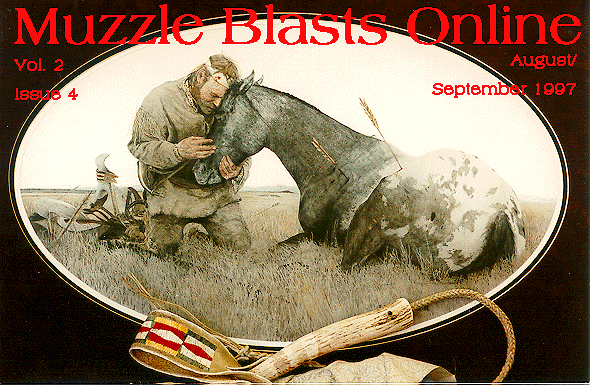|
Muzzle Blasts Online |
|
...for the muzzleloading enthusiast |
|
The muzzleblasts.com domain, subdomains, content, etc., are neither affiliated with the NMLRA nor its paper magazine Muzzle Blasts |
|
Muzzle Blasts Online |

|
|
|
|
|
|
Slug Gun Shooting Tips
Back in the 1940's and early 1950's, there was a very active and skilled gunsmith and shooter who worked and shot slug guns. His name was Lester Cox. I have a picture of Lester receiving the slug gun aggregate medal at the 1950 Friendship National Championship matches. He died of a heart attack a few years later, shortly after returning home from another Friendship shoot.
Lester made numerous slug guns and left a very important set of instructions on building them. I believe he probably had intended to have these published, but didn't get to it. I have a set of these instructions, eleven pages, and I have donated a copy to the National Muzzle Loading Rifle Association library so that it will be available to interested parties to read and perhaps to copy. I will summarize some of the important parts of the article so that those that may be interested will know what material it contains.
At the heading of this article there is hand written note as follows: "I try and show how I make and match my bullets to the bore of the rifle I intend to use them in; also how I make and install the false muzzles used on them."
First he presents a table that gives length of bullet, bore diameter, and tangent of twist to bore. The above is to be used with one or more grains of powder to 5 grains of lead. He then gives another table that is the angle of twist required for the following bullets length to bore size. He then gives the aperture size of the front sight when using iron sights at 50, 100, and 200 yards.
The ratio of powder to lead for slug rifles is as follows:
| Powder | Lead | Approximate Velocity |
|---|---|---|
| 1 | 7 | 1247 feet per second |
| 1 | 6 | 1340 feet per second |
| 1 | 5 | 1475 feet per second |
| 1 | 4 | 1650 feet per second |
Most slug rifles will use around 1 to 5 or 1 to 6, or somewhere in between.
Mention is made of using the two piece bullet that is hard on the front portion and pure lead on the rear section. The best composition for the hard nose end is given as a melted mixture of 2 pounds of linotype mental (unused), 1 pound pure lead, and 1 ounce pure block tin.
Next are complete instructions for making and installing a false muzzle. This is very complicated and extensive instruction and anyone interested should study the complete instructions. A diagram of the two piece bullet and instructions for making both a bullet mold and swage are included, as are the steps in making the half round reamer that is required in order to make the bullet mold and swage. These instructions are very complete and are too extensive to be included here. Next, instructions are given for making the bullet starter. Complete instructions are given for making the bullet mold and the two piece hard lead and pure lead parts and the swaging of these two parts together to form the finished bullet. Finally, a sketch is given of the finished bullet starter and a description of all of its parts.
This article is a brief summarization of the complete article and those interested should see it at the NMLRA library and perhaps copy it. It is further suggested that the reader read a copy of "The Improved American Rifle" by Jon A. Chapman . This book is also in NMLRA library.